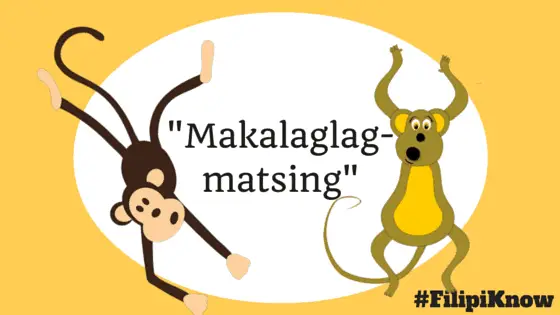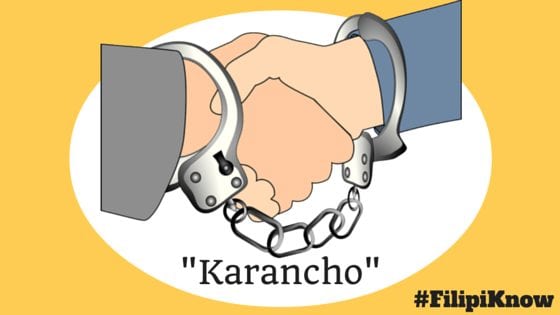19 Common Pinoy Expressions Younger Generations Won’t Understand

Someone once asked me what a makinilya is, and that’s when I realized how old I am compared to today’s teenagers. As we all know, it’s the Filipino word for a typewriter, a reliable writing machine now considered ancient–so much so that young folks don’t even know what it is called, let alone how to use it.
This reminds me of other words that are familiar to my ears, but not for someone born in the year 2000 onwards. Remember, most of these young folks just came out of their mother’s womb while the rest of us were trying to survive puberty.
So exactly how many “old” words and expressions separate us from these younger millennials? Answer: A lot. And here are just some examples:
Also Read: 3 Pinoy Expressions With Crazy Origins You Would Never Have Guessed
1. The use of “almirol” in washed clothes.
Long before we started using fabric conditioners on clothes to make ironing a lot easier, Filipinos from long ago relied on their good ‘ol almirol. It refers to the cornstarch (gawgaw) used to stiffen clothes. Our moms and grandmas would usually mix the cornstarch with water, soak the clothes to the mixture, and let them dry. The process often results into clothes that are so stiff they can already stand on their own.

2. “Para kang sirang plaka!”
This originated from the English expression “You sound like a broken record” referring to a person who repeats the same thing over and over again.
Throughout the 20th century, people enjoyed music by playing discs called records (or “plaka” in Filipino) on a device called phonograph/gramophone. You know you have a damaged disc when the same sound is repeated again and again, hence the expression.

3. “Panahon pa ni Mahoma yan.”
When you say nineteen kopong-kopong, you usually refer to an era–specifically the 1900s–that is so long ago nobody remembers it anymore. “Panahon ni Mahoma” has a similar meaning, but this time it identifies the person whom the expression was named after.
Related Article: 11 Filipino Slang Words With Surprising Origins
According to UP Diksiyonaryong Filipino, Mahoma is the Spanish name of Muhammad, a Muslim prophet who lived in the 6th century and has been regarded as the founder of Islam.
Other elders prefer to use Limahong instead of Mahoma. The former is a reference to a 6th-century Chinese pirate who tried but failed to invade Manila. In other words, “panahon ni Limahong” also suggests a bygone era, and people use it in conversations to emphasize how outdated a thing or an idea is.

4. “Naniningalang-pugad.”
When a guy is courting a girl the traditional Filipino way, you can say that he’s “naniningalang-pugad.” It brings us back to those days when Filipino houses had balconies where young Filipinas would watch as their male admirers serenade them with kundiman or love songs.
5. “Giyera patani.”
Politicians engaged in a heated verbal exchange are said to be in “giyera patani” with each other. Old folks also use this expression when referring to two or more people who are having an argument.
In case you haven’t seen one, a patani (or lima bean in English) is a pod vegetable containing up to 4 large colored seeds. These seeds are lightweight and won’t cause serious harm when used to hit a person.
Also Read: 30 Filipino Words With No English Equivalent
Therefore, when you say “giyera patani,” it only means that two or more people attack each other verbally but the fight is never serious enough to cause physical injury, or to involve dangerous weapons.
6. “Sanggang dikit.”
Filipinos have different terms of endearment for their friends: buddy, BFF, tropa, barkada, you name it. But when you describe the bond between you and another person as “sangggang dikit,” you consider him/her as your best friend.
A person like this has stuck with you through thick and thin, and even joined you in doing the craziest of things. Hence, you consider this person your “better half”–but not in the romantic sense.
7. “Makalaglag-matsing.”
Most monkeys live in trees. That’s where their comfort zone is. So when something grabs their attention enough to make them fall from the tree, you know it’s something.
Perhaps this was how the Filipino idiom “makalaglag-matsing” was coined. It’s so old that the expression appeared in the 1914 book “Agawan ng Dangal” by Fausta Cortes. It usually means beautiful or enchanting, as in “ang kagandahan niya ay makalaglag-matsing.”

8. “Putok sa buho.”
Legend has it that the Filipinos and the entire human civilization owe their origins to two people: the first man, Malakas (Strong), and the first woman, Maganda (Beautiful). According to Philippine mythology, both emerged from a bamboo that was split open with the help of a bird.
Also Read: The Pinoy President Who Was An Illegitimate Child
This creation story is said to be the origin of the expression “putok sa buho” (sprout from the bamboo). It underscores the fact that Malakas and Maganda came out of nowhere, and with no known parents. For this reason, Filipinos today often use the expression to refer to an adopted child (whose parents and their whereabouts are unknown) or a bastard (a fatherless child).
9. “Alilang-kanin.”
If servants have a hierarchy, you’ll probably find alilang-kanin at the bottom. This is because alilang-kanin are servants that are not paid with money. They only work for food. This abusive treatment is usually experienced by orphans who end up working for their cruel relatives (think Cinderella).
10. “May ipot sa ulo.”
Literally translated as “poop in the head,” this Pinoy expression is a euphemism for a man who has been cheated by his wife or partner, but doesn’t know it yet. Worse, almost everybody knows about it (or can see the “poop” in his head, so to speak) except him.
11. “Consuelo de bobo.”
Consuelo de bobo (or “consolation for the idiot”) is a band-aid solution or a mock consolation given to those who have just suffered loss, rejection, or other hardships in life. And as the definition suggests, the benefits or relief a person gets from consuelo de bobo are anything but permanent. Think of the money handed out by politicians to poor communities or the prize given to runner-ups in a contest.
12. Spanish loanwords such as antemano, portamoneda, and eskaparate.
These are just some of the words we borrowed from our Spanish colonizers and now often used by our older relatives.
READ: 6 English Words You Didn’t Know Have Filipino Translations
According to UP Diksiyonaryong Filipino, the word “antemano” means “sa una pa/noon pa” or “agad.” Both “portamoneda” and “eskaparate,” on the other hand, are alternative names for familiar things: the former is another word for wallet or bag, while the latter is an old term for a closet or aparador.

13. “Topo topo barega.”
This relatively obscure expression is used as an incantation by a person who found an item so that its original owner won’t cast bad spell on him.
In the trivia book Malictionary by Ernie Zarate, topo topo barega is said to have come from the words “barriga,” which means “belly,” and “topo,” which in Spanish means “spy, mole.”
Its etymology doesn’t makes sense, but those who use the expression today usually translate it into “walang bawian” (or “no taking back”).
14. “Walang katorya-torya.”
People used to describe a boring movie as “walang kaistorya-istorya” which means it has no story at all. As time went by, it condensed into “walang katorya-torya” and now used to describe anything uninteresting–be it a movie, book, person, etc.
15. “Bulang-gugo.”
When you call someone bulang-gugo, it means that he or she is generous or what most Filipinos call “galante.” It was probably named so because the gugo, or the native Filipino shampoo made from the bark of a tree, produces a lot of foam when soaked and rubbed in water.
16. “Basag ang pula.”
Egg yolk (pula ng itlog) is usually at the center, and where almost all the nutrients are concentrated (sort of like the human brain which serves as our ‘central switch’). Using the same logic, the Filipino expression basag ang pula (‘broken’ egg yolk) eventually became a euphemism for insane or crazy person.
Also Read: Bakit kulay dilaw ang pula ng itlog?
17. “Hilong-talilong.”
According to the book Malictionary by Ernie Zarate, this either means “madly in love” or a person who is in a “hurried frenzy” so much that he/she already acts like a headless chicken.
18. “Kahiramang-suklay.”
Similar to “sanggang-dikit,” this Pinoy idiomatic expression refers to a friend whom we share intimate relationship with–so intimate that we no longer mind sharing a personal comb with him/her. You normally don’t allow someone to use your personal items (such as a comb) unless you trust that person.
19. “Karancho.”
Long before karancho became a slang term for “buddy,” it was a prison jargon widely used by Filipino inmates.
READ: 70 Things You Didn’t Know Had Filipino Names

Prisoners are usually divided into different clusters, each of which is called rancho. They are organized that way to facilitate the proper distribution of food. A representative of each rancho typically receives the share of the entire cluster, which he then distributes among all its members (karancho).
The word was later adopted by the outsiders and even coined variations like chokaran or ka-chokaran (reverse of the original karancho) or simply choy.
References
Almario, V. (2010). UP Diksiyonaryong Filipino (2nd ed.). Quezon City: UP Sentro ng Wikang Filipino-Diliman.
consuelo de bobo. Wiktionary. Retrieved 5 March 2016, from https://goo.gl/8DD8kX
Cordero-Fernando, G. (2015). ‘Putok sa buho!’. Inquirer.net. Retrieved 4 March 2016, from http://goo.gl/eZ6PSC
Tagalog Idioms. Tagalog at NIU. Retrieved 4 March 2016, from http://goo.gl/V68XIj
Zarate, E. (2007). Malictionary 2 (pp. 61, 111, 114). Mandaluyong City: National Book Store.
Zarate, E. (2009). Malictionary 3 (pp. 75, 83, 86, 87). Mandaluyong City: National Book Store.
FilipiKnow
FilipiKnow strives to ensure each article published on this website is as accurate and reliable as possible. We invite you, our reader, to take part in our mission to provide free, high-quality information for every Juan. If you think this article needs improvement, or if you have suggestions on how we can better achieve our goals, let us know by sending a message to admin at filipiknow dot net
Copyright Notice
All materials contained on this site are protected by the Republic of the Philippines copyright law and may not be reproduced, distributed, transmitted, displayed, published, or broadcast without the prior written permission of filipiknow.net or in the case of third party materials, the owner of that content. You may not alter or remove any trademark, copyright, or other notice from copies of the content. Be warned that we have already reported and helped terminate several websites and YouTube channels for blatantly stealing our content. If you wish to use filipiknow.net content for commercial purposes, such as for content syndication, etc., please contact us at legal(at)filipiknow(dot)net